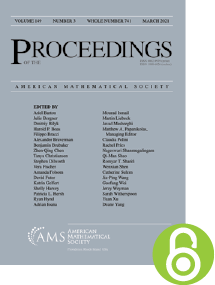On a class of finite-dimensional Lie algebras
HTML articles powered by AMS MathViewer
- by Ralph K. Amayo PDF
- Proc. Amer. Math. Soc. 78 (1980), 193-197 Request permission
Abstract:
Over fields of prime characteristic the centre of the universal enveloping algebra of a finite-dimensional Lie algebra contains a finitely generated polynomial algebra over which the universal envelope is a finitely generated module. This result, which is due to Curtis, is crucial in certain investigations of finitely generated soluble Lie algebras and motivates the introduction of the class Max-cu, which will be called the class of Curtis algebras, consisting of Lie algebras whose universal envelopes have the property described above. It has been an open question whether the class Max-cu consists of finite-dimensional Lie algebras. This paper gives an affirmative answer to the question.References
-
R. K. Amayo and I. N. Stewart, Infinite-dimensional Lie algebras, Noordhoff, Leyden, 1974.
- Ralph K. Amayo and Ian Stewart, Finitely generated Lie algebras, J. London Math. Soc. (2) 5 (1972), 697–703. MR 323850, DOI 10.1112/jlms/s2-5.4.697
- Ralph K. Amayo, Engel Lie rings with chain conditions, Pacific J. Math. 54 (1974), 1–12. MR 360727
- Charles W. Curtis, Noncommutative extensions of Hilbert rings, Proc. Amer. Math. Soc. 4 (1953), 945–955. MR 59254, DOI 10.1090/S0002-9939-1953-0059254-7
- Nathan Jacobson, Lie algebras, Interscience Tracts in Pure and Applied Mathematics, No. 10, Interscience Publishers (a division of John Wiley & Sons, Inc.), New York-London, 1962. MR 0143793
Additional Information
- © Copyright 1980 American Mathematical Society
- Journal: Proc. Amer. Math. Soc. 78 (1980), 193-197
- MSC: Primary 17B65; Secondary 16A64, 17B15
- DOI: https://doi.org/10.1090/S0002-9939-1980-0550492-X
- MathSciNet review: 550492


